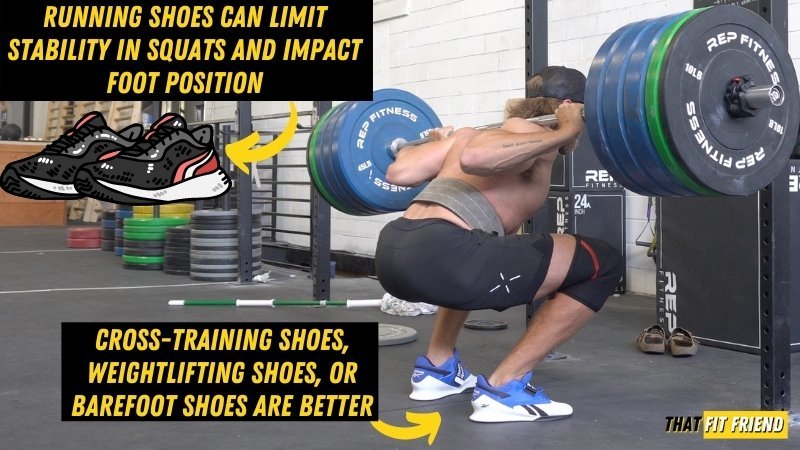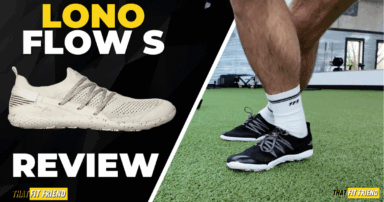Table of Contents+
Shoes can be a make or break for performance, especially when you get more serious about your training.
One of the common questions I receive from resistance training beginners on cross-training shoe articles and videos is,
“Can I just use my running shoes for lifting weights?” I then answer with, “You technically can, but it’s not ideal and your performance could be hindered when lifting with running shoes.”
This response is usually followed by a few more follow-up questions, including “Why not?” “What shoes should I look for then?” and “Why are running shoes not great for lifting?”
Squat/Deadlift In Running Shoes Takeaways
Can I Deadlift In Running Shoes?
You can, but I suggest not doing so. Strong deadlifts start from the floor. Ideally, we want to limit the amount of material that separates the foot from the floor. This will improve our overall range of motion and stability, which is key for strong deadlifts.
Most running shoes have higher stack heights due to thicker midsoles and outsoles. This means that the overall material that separates the foot from the floor is more grandiose in running shoes compared to shoes like cross-training shoes and barefoot shoes.
When deadlifting, we’ll want to create a tripod foot position, which is the ground of the base of the heel, big toe, and pinky toe. I also like to coach finding the ground with the big toe. This foot position will improve our positioning and abilities to drive through the ground during deadlifts, which will make us stronger off the floor.
As you progress through your lifting career, you’ll likely experience and learn that deadlifts are most difficult through the first 30 degrees of range of motion. If we’re wearing running shoes that put us further from the floor and limit our potential to generate power, then we’ll be deadlifting on shaky ground.
In addition to the above, running shoes are also more prone to compressing under heavy loads. Imagine you had to pick up something heavy from the floor and you had two options: stand on a pillow or a concrete floor.
Which option would give you the most stable base? The concrete floor. The same goes for footwear, especially as you get stronger in your lifting career. Thicker shoes, like running shoes designed to provide reactivity and bounce, will have a threshold in which the external load causes them to compress.
Why You Shouldn’t Deadlift In Running Shoes
- They generally increase the range of motion in which you need to lift a weight.
- They limit and can decrease stability due to their structure and design.
- They compress at certain thresholds, which can cause deadlift mechanics to break down.
What To Wear Instead
- Deadlift Shoes
- Converse, Vans, and Other Zero Drop Shoes
- Barefoot Shoes
- Stability-Focused Cross-Training Shoes
- Nothing, Go Barefoot!
Can I Squat In Running Shoes?
Similar to deadlifts, you can technically squat in running shoes, but most will benefit by not doing so. I broke these sections into different parts because the rationale as to why running shoes fall short is slightly different. Plus, squats and deadlifts are different exercises with different demands.
Strong squats start with the feet and strong eccentric mechanics, A.K.A. the portion of the movement in which you’re squatting down before standing up.
When we wear running shoes that have thick midsoles and outsoles, we’ll have a tougher time stabilizing the feet in the squat. During the lowering phase in the squat, we have a ton of potential to absorb the load and prep the body and muscles for the standing phase, in which we’ll displace a vertical force into the ground.
If the feet are not grounded, then we could experience a few things happen in the squat,
- We could lose our balance due to a lack of stability
- We could shift our mechanics slightly due to the shoes compressing
- We can lose out on the potential to truly feel the ground and use it to produce force.
On top of this, a lot of running shoes are designed with a more curved structure which makes it even more difficult to ground and stabilize your squat through the feet.
A few other issues that can occur down the road as you continue to add load include 1) compression can occur at certain load thresholds, which can cause squat mechanics to break down, and 2) squat walkouts can get more sloppy and dodgy as the weight gets heavier.
If our shoes are compressing or we’re having a difficult time stepping back with the weight due to shoes compressing under us, then it’s easy to see how this can be problematic for those trying to maximize their squat performance.
Why You Shouldn’t Squat In Running Shoes
- They decrease your ability to create stability from the ground up; it’s like building a house on a muddy foundation.
- They can compress under certain loads, which can impact balance and mechanics.
- They can impact things like squat walkouts due to their thicker and more compressive construction.
What To Wear Instead
- Weightlifting Shoes
- Stability-Focused Cross-Training Shoes
- Converse, Vans, and Other Zero Drop Shoes
- Barefoot Shoes
Can I Work Out In Running Shoes?
Outside of squats and deadlifts, let’s discuss tackling general workouts in running shoes. These could include free weights, machines, and other exercises that are not necessarily super heavy or specialized in nature.
Similar to the above, you can technically work out in running shoes, but I’d ask, “Is it optimal, and do you have to?”
Running shoes are designed to support one style of activity: running. Performance dropoffs will always occur when using them for working out in the gym. A running shoe’s inability to promote stable foot positions and resist compression will always be something to consider when working out with running shoes.
Even if you’re using things like machines, your footwear does matter to a degree. Let’s say you’re doing leg presses, even though you have a constraint like a seat and pad to stabilize the body, the feet could still lack stability due to a running shoe’s construction.
To take it a step further, as you get more technical with your training, you can actually bias certain adaptations during exercises by focusing on how you’re displacing pressure in the feet. For example, if you’re doing leg presses with a quad bias, then you’re going to want to ensure you’re finding your big toe and allowing maximal dorsiflexion to occur.
Coaching Note: Dorsiflexion is when the ankle flexes upward with the toes pointing to the sky. When we want to bias the quads in exercises, we’ll want to promote more knee tracking and by “finding the big toe” we can ensure we’re getting the most out of our bias-focused training!
If we’re wearing thick running shoes, we can once again lose the ability to fully feel the implement we’re using to create biases and stability. In this example, it would be the platform of the leg press.
These are subtle details that often get overlooked by beginners and those that lack intentional programs. Will wearing running shoes in the gym kill you? No, but they’re far from optimal as you get more specific and serious about your workouts.
Is It Bad to Work Out In Running Shoes?
When answering this question, we need to be careful with how we use and define “bad”. In any context, when we say “bad”, we’ll all have our own definitions come to mind, some being more serious than others.
For example, how I define “bad” from my coaching point of view will likely be different than how you define bad as a lifter, athlete, or coach.
That being said, I wouldn’t say it’s “bad” to work out in running shoes; it’s just not optimal in a lot of contexts. If you want the most out of your performance and your gear, then it can be helpful to get more specific with what you’re using.
Wearing running shoes while working out is like playing tennis with a ping pong paddle. Can you do it? Sure, but is it going to be optimal to match the task at hand? No. You’d be far better suited using a tennis racket which is designed for tennis.
So, instead of using words like “bad”, I’d suggest shifting the focus to a performance output point of view. This will create less emotional biases towards certain gear and training methodologies and allow you to make better objective choices for gear.
What Shoes Should I Work Out In?
Instead of opting for your running shoes for working out, I’d suggest exploring more general training shoes, cross-training shoes, and even barefoot shoes. These types of shoes will be better for working out and will support your maximal performance output.
When comparing the endless training shoe options for working out, I suggest scaling selections according to the specificity or specialty of your training style.
By creating an ebb-and-flow approach, you can objectively identify which types of footwear would be best for your specific needs. Basically, this will help you avoid buying something like a super HIIT-focused training shoe for barbell training.
Even though they’re both training shoes, their construction and performance will differ. If you ever have questions about specific models, make sure you check out my individual shoe reviews or reach out to me personally and ask questions.
Below, I made a little graph to highlight where each style of shoe can excel. Note that every shoe can technically work in the prescribed training sections below, but there will always be certain construction aspects designed for specific activities.
Different Types of Workout Shoes
- Barefoot Shoes: Once you’ve acclimated to them, they’re best for lifting and HIIT-style training. They can also work for classes and athletic work, but I left them off here because you’ll need adequate time to acclimate to them before using them full-time for these styles of activities.
- Training Shoes: Best for HIIT, classes, and athletic-focused training where the goal is not maxing out or lifting as much as possible on regular basis. These shoes will typically have thicker midsoles and outsoles to promote versatility.
- Cross-Training Shoes: Best for everything, however, they can be uncomfortable at times for things like HIIT, classes, and athletic-focused work depending on what you prefer to wear. For example, more stable cross-training shoes will work for all activities but can be a bit uncomfortable for HIIT, classes, etc.
What’s most important is finding a pair of shoes that matches your needs. There are endless construction features designed to promote performance in specific settings, and having some idea of what you want, need, and prefer can be key for long-term success.
Takeaway Thoughts
When talking about lifting weights in running shoes, we must be cognizant of our abilities, wants, needs, and preferences. Much like other pieces of supportive gear for sports and training, different shoes will be better than others for certain settings like running and working out.
If you have any questions about this article, please comment below or feel free to contact me personally!

















Add a Comment